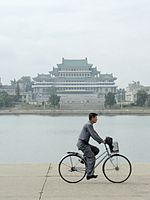
Cycling has become a common mode of transport in North Korea since its economic transition in the early 1990s.
A ban on bicycles in the country's capital and largest city, Pyongyang, in existence for decades, was suddenly lifted in 1992, and according to Andrei Lankov, bicycles have since "proliferated" and their use has "visibly increased" in other urban areas. However, their price, meager by international standards, still puts them out of reach of a significant portion of the populace. A modest infrastructure, including bicycle lanes and bicycle parking, has likewise developed. Foreign and domestic bicycles are available, with used Japanese models particularly coveted.
Cyclists must reportedly obtain a license by passing a road safety test, and must register bicycles and display a corresponding tag as proof, though the law is often flouted outside the capital. Conflicting reports exist that women are, or have been, banned from riding bicycles, with some claiming the ban to be a personal edict of Kim Jong-il; however, female cyclists are a common sight in North Korea's large cities, indicating this law, too, if it ever existed, is widely ignored.
Ryomyong bicycle-sharing

In 2017, Tongil News reported the introduction of a bicycle-sharing system in Pyongyang, called Ryomyong (려명 "Dawn"), sharing photographs from the Russian embassy. The Pyongyang Times later published photographs of stations, reporting that the system is overseen by the Pyongyang Bicycle Rental Office (평양자전거임대관리소), with bicycles manufactured domestically by a North Korean/Chinese joint venture, Phyongjin Bicycle Cooperative Company (평진자전거합영회사), located in Sosong district (서성구역). Reservations may be made for 50 won per minute with a stored-value card at one of five locations on Kwangbok Street in the city's scenic Mangyongdae district.
Gallery
-
 Cyclists in Chongsan-ri, Kangso, 2008
Cyclists in Chongsan-ri, Kangso, 2008
-
 Cyclists in Haeju, 2008
Cyclists in Haeju, 2008
-
 Young woman with bicycle, Kaesong, 2010
Young woman with bicycle, Kaesong, 2010
-
 Bicycles crossing a street, Hamhung, 2012
Bicycles crossing a street, Hamhung, 2012
-
 Cyclist using a mobile phone, Hamhung, 2012
Cyclist using a mobile phone, Hamhung, 2012
-
Bicycles with visible North Korean registration plates in Pyongyang, 2012
-
Morning bicycle traffic in Kaesong, 2012
-
 Cyclist transporting cargo along the Kaesong-Nampo motorway, 2015
Cyclist transporting cargo along the Kaesong-Nampo motorway, 2015
-
 Bicycles with visible North Korean registration plates in Kaesong, 2015
Bicycles with visible North Korean registration plates in Kaesong, 2015
-
 A woman pushing a bicycle near Kangso, 2015
A woman pushing a bicycle near Kangso, 2015
-
 Bicycle parking in Kangwon, 2015
Bicycle parking in Kangwon, 2015
-
 Two men with bicycles, Pyongyang, 2016
Two men with bicycles, Pyongyang, 2016
See also
References
- ^ Lankov, Andrei (2007). North of the DMZ: essays on daily life in North Korea. Jefferson, N.C.: McFarland & Co. p. 141. ISBN 978-0-7864-2839-7. OCLC 81252830.
- "70% of Households Use Bikes". Daily NK. 30 October 2008. Archived from the original on 6 July 2014. Retrieved 16 June 2014.
- ^ "North Korea introduces cycle lanes in Pyongyang". The Guardian. July 14, 2015. Retrieved September 28, 2019.
- "North Korea Bans Women From Riding Bicycles...Again". CBS News. 17 Jan 2013.
- Seok, Kay. "Human Rights in North Korea". The Korea Times.
- "'평양 거리에 자전거 대여소 설치...7월부터 운영'<주북 러 대사관". Tongil News (South Korea). 7 July 2017.
- North Korea Economy Watch: Pyongyang Bike Share
| Africa | |||||||||
|---|---|---|---|---|---|---|---|---|---|
| Asia | |||||||||
| Europe |
| ||||||||
| North America |
| ||||||||
| Oceania | |||||||||